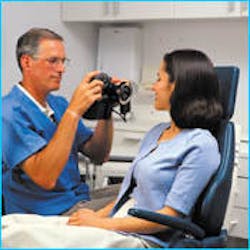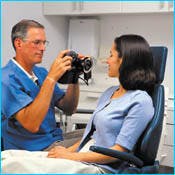Every Photo's Story, Every Patient's story
If used wisely, intraoral and digital cameras help build rapport with patients.
by Benjamin P. Hornstein, DDS
How does your practice use images? In 2001, dental practices use many different types of imaging equipment. We use X-rays, of course, to diagnose. However, we have also discovered new uses for images, including treatment planning, communication, and documentation. In my practice, images are also an important tool for building relationships with our patients.
Like many practices, we own several types of imaging equipment. Two very important tools are our intraoral and digital cameras. At first glance, these cameras seem to function in a similar way. Both take pictures of teeth. However, they are suited to very different roles in the dental practice.
The most obvious difference between intraoral and digital cameras is imaging area. Intraoral cameras are well-suited to image small features, such as a single tooth or even a single cusp. They enlarge these relatively small features by up to 25 times their actual size.
Intraoral cameras are also useful for capturing information "on the fly" in the operatory. For example, if a hygienist notices a problem while cleaning a tooth, she uses an intra-oral camera to capture an image of that tooth.
Digital cameras, on the other hand, can capture a patient's entire face or a complete smile. They are great for anterior shots and are especially useful in practices that offer restorative or esthetic services. For example, digital cameras are ideal for creating before-and-after images of restorations.
Here's a look at how we use intraoral and digital photography in our practice, and how the two types of imaging complement each other.
Different cameras, different applications
In my practice, we do not treat patients "one tooth at a time." Instead, we consider our patients' total health, ranging from periodontal and nutritional to functional, esthetic, and articulation issues. We've found that many of these areas are interrelated. The functional health of teeth is often connected to their esthetics, for example.
We also make it a point to spend time with our patients and to listen to them. We've found that building rapport is critical to the success of the practice.
Photography plays an important role at every step, starting with a new patient's first appointment. New patients always begin with a half-hour consultation with me. This consultation sets the tone for how we relate to patients in my practice: We let the patients guide us. We never tell patients what they 'need" or what course of treatment they should follow. Our philosophy is that dental procedures are elective. Plenty of people walk around without teeth and have survived. They make do with dentures and are just fine.
So instead of putting ourselves above our patients, and telling them what they "need" to do, we let our patients choose what they'd like to do. Our job is to listen.
Every patient has a story. The purpose of my initial consultation is to listen to that story. I do very little talking, except to ask questions. I let the patient talk. Sometimes, it seems like the patient has very little to say. Then, after awhile, the story will come out. You learn that a patient's gums bleed when he flosses, or she has pain when she eats ice cream. People will tell me, 'My mother wears dentures, and I don't want to have that happen to me."
This is the information that forms the basis for treatment planning.
However, my consultation room is also a portrait studio. It's equipped with a strobe flash, umbrellas for directing the lighting, a choice of colored backgrounds, a posing stool, and a posing table. The walls display our photographs of happy patients. Some are framed, and some are mounted on a frameless backing by a local photo lab. Most are in color, but I can also produce black-and-white photos.
As part of the initial consultation, we take the new patient's photograph. Sometimes I take the photo. But I also have an assistant who is a wonderful photographer. We always have fun with this part of the consultation, and our patients enjoy it immensely.
I have used both 35mm film and digital photography for this session, but we now use digital photography exclusively for our initial set of images. I have a Kodak DC290 Digital Camera (sold to dentists as part of the Kodak Dental Digital Photography Kit 290). It takes great pictures and is a terrific all-around camera, especially for practices that are just starting to use digital photography. All of my staff members are trained to use the camera. The kit comes with a color inkjet printer, too, which I use for producing my prints. We also use photographic-grade paper for producing prints, another key to great-looking output.
The initial set of pictures documents the patient's teeth and smile. I use these prints in a variety of ways. For example, we always attach a 4x6 print of the patient to his or her file. That way, on return visits, we recognize the patient and can greet the patient by name. I also use the initial set of images for insurance documentation. If a dental benefits company misplaces an image, we can simply print out another copy.
These images also reduce the risk of 'buyer's remorse." I've often found that after an esthetic procedure, patients forget how their teeth looked before. Now, we always present a 'before" picture at the conclusion of treatment. In fact, when we do whitening, we display the 'before" picture right in the whitening room. When the treatment is done, the patient can see the difference immediately. This never fails to remind patients why they decided on a course of treatment in the first place.
"Don't show that to me!"
With photography completely integrated into our practice, you might think we always share every image with our patients. We don't. In fact, I've found that patients may resist images of their teeth. Some think pictures of teeth are ugly.
Equally important, showing patients pictures of their "problems" can make them defensive. They feel like you are criticizing them. For this reason, we always ask our patients' permission before showing their images. This is true for both digital camera and intraoral camera photographs.
Sometimes, in the initial consultation, I use photographs of other patients. (We ask our patients to sign release forms to ensure we always have permission, ahead of time, to share pictures of them with other patients.) This is often less threatening. For example, perhaps I have a patient with bleeding gums. I might show this patient a picture of someone else who had similar symptoms. I'll explain that the other person was beginning to develop periodontal disease and was at risk of infection and other complications.
At some point, most patients will ask, "Is that happening in my mouth?" The patient has led the conversation. I haven't forced my point of view. Instead, I've used images to give the patient a focal point for asking questions. I'm not an adversary, and the patient and I are now working together.
Intraoral Cameras
A digital camera is a great tool for photographing smiles. It fits well with documentation and esthetic treatment planning.
Intraoral cameras are more of a diagnostic tool. We have two cameras in my practice: an inexpensive, portable Telecam by DMD, and a Reveal camera by Welsh Allyn (which has recently been discontinued). We have docking bays in all five of our operatories.
With intraoral cameras, we are especially careful about showing images to our patients. We are also scrupulously ethical. These cameras magnify every blemish and stain. We are careful never to mislead patients about what they are seeing on the screen.
Intraoral cameras can help patients understand exactly what is happening with individual teeth. They can show periodontal pockets and bleeding problems, as well as tooth decay.
In our office, our hygienist always captures several views during teeth cleaning. We look for both positive and negative news. That way (assuming the patient wants to see), we can show both good things, such as how great that old filling still looks, as well as potential problems.
Intraoral cameras generally don't provide true color. However, they are a great adjunct to X-rays for treatment planning. We always print two copies of our intraoral images. We keep one printout in the file to help with case documentation and review. The second is for submission with dental benefits.
We also use intraoral cameras at the completion of restorative procedures. We love to take pictures of new white fillings, show them to our patients, and hear them say, "It looks just like a real tooth!"
One for the road
Digital photography plays a similar role once an esthetic or restorative procedure is complete. After restorations, we always return to our portrait studio to take 'after" shots. Often, we throw a mini party for the patient (I've even been known to open a bottle of wine after a major restoration).
Many times, we present a photo to the patient as a gift. This is a terrific practice-builder, since the patient often shares the photo with friends and family. Our digital camera is particularly helpful for this, since we can capture and print the photo right in the office. The patient can take it home at the end of the appointment.
We've also found that just having a digital camera impresses patients. Patients like to think their dental office is using the very latest equipment. Our digital camera shows them we are staying abreast of cutting-edge technology.
Images do not replace verbal skills. Everyone in my office — including my assistants and hygienist, as well as me — continually work to improve our rapport skills. We work at listening to our patients and seeing our practice through our patients' eyes.
With these skills as the foundation, however, imaging can be a terrific tool. It is also fun for us, and our patients.
Benjamin P. Hornstein, DDS, is with the Center for Advanced Dentistry in Beachwood, Ohio.

